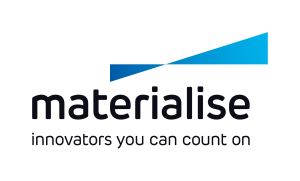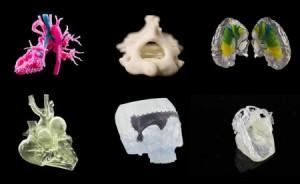Materialise CEO Calls for Improved Clinical Measurement Standards to Help Expand Medical 3D Printing
 There’s no denying that 3D printing technology is steadily changing the shape of the medical industry, whether it be through anatomical models, guides, implants, or the many other applications that continue to become more widely accepted and used in healthcare services across the world. One of the top providers of the healthcare-driven 3D printing revolution is the Leuven, Belgium-based Materialise NV. Focused on academia, medical device companies, and the hospital environment, Materialise has gained quite a stronghold on the medical industry over the past few years.
There’s no denying that 3D printing technology is steadily changing the shape of the medical industry, whether it be through anatomical models, guides, implants, or the many other applications that continue to become more widely accepted and used in healthcare services across the world. One of the top providers of the healthcare-driven 3D printing revolution is the Leuven, Belgium-based Materialise NV. Focused on academia, medical device companies, and the hospital environment, Materialise has gained quite a stronghold on the medical industry over the past few years.
Last year, we covered the service bureau’s partnership with medical product development company Kapstone Medical, as well as a five-year deal with Japan’s Medical Dynamic Marketing, Inc., who partnered with Materialise for 3D printed hip replacements. Their biomedical software, called the Mimics Innovation Suite, is respected across the industry for its quality patient-specific 3D modeling capabilities. Just recently, Mimics proved itself ready-and-able to help provide successful thyroplasty surgery to trans women , and has also just become the go-to 3D modeling software for the Japan-based healthcare provider Canon Lifecare Solutions.
So it seems safe to say that Materialise is the proper leader for creating more generally accepted measurement standards for medical-based 3D printing, and their CEO, Fried Vancraen, is calling for an experienced initiative to develop this tightened approach. With a globally accepted set of guidelines, the medical 3D printing industry can better persuade physicians, hospitals, and policy makers to adopt this increasingly valuable technology. With a developed set of clinical measurement standards for the medical use of 3D printing, government bodies and insurance companies are also more likely to add medical 3D printing to their approved list of medical procedures and devices, which will allow patients access to the most modern, technologically-driven healthcare solutions.
“There have been several initiatives aimed at properly measuring and validating the clinical benefits of medical 3D Printing, but all have suffered from a lack of coordination and agreed-upon research methodologies,” Vancraen stated. “The fact is, we can only be successful if we take an evidence-based approach across the industry, acting in concert with a set of protocols, methodologies and measurement guidelines. With the proper scientific rigor, our ambition of gaining widespread acceptance of medical 3D Printing will be realized more swiftly, and the patients whom we aim to serve will benefit the most.”
To help jumpstart the initiative, Materialise will lead the way by studying and designing an evidence-based approach to create these clinical standards, which will include an economical, clinical, engineering and patient-based focus. According to Vancraen, Materialise’s goal is to set the groundwork for more solid measurements, which will help validate a variety of medically-driven 3D printing applications, including anatomical models, patient-specific guides, and implants. With these plans, Materialise can help ingrain 3D printing technology even more deeply into the medical industry by producing more solid clinical evidence, which should further incline physicians, hospitals, and other medical organizations to implement 3D printing into their own healthcare services.
Materialise will be presenting this on-going initiative at Building Evidence for 3D Printing Applications in Medicine, an event hosted by SME and sponsored by Materialise. This event will follow the RAPID Conference, an annual 3D printing conference that will take place at the Orange County Convention Center in Orlando, Florida from May 19-20. If you’d like to learn more about this well-rounded approach to creating better clinical measurement standards for 3D printing, you can either register for the upcoming event or—for those not in the vicinity of the in-person discussion—request more information from the Materialise website. Discuss in the Materialise 3D Printing and Clinical Evidence forum over at 3DPB.com.
[Source: Materialise NV via Ortho Spine News]
Subscribe to Our Email Newsletter
Stay up-to-date on all the latest news from the 3D printing industry and receive information and offers from third party vendors.
Print Services
Upload your 3D Models and get them printed quickly and efficiently.
You May Also Like
October in Pink: 3D Printing’s Role in Healing and Hope
Each October, the world turns pink to remind us of a difficult truth: breast cancer is still the most common cancer among women. While survival rates keep improving, the path...
Atlanta VA First in U.S. Veterans Health Care System to Offer 3D Printed Casts & Splints
The potential for additive manufacturing (AM) in the military is by no means limited to applications like propulsion hardware, drones, and explosives. 3D printed medical devices, for instance, have attracted...
China Builds World’s Largest 3D Printed Drug Factory in Nanjing
In the Jiangning high-tech zone of Nanjing, China, a new kind of pharmaceutical factory is emerging, except that this is not the usual conveyor belt or assembly line pharma factory....
3D Printing News Briefs, September 6, 2025: SBIR Awards, Regenerative Medicine, & More
In this weekend’s 3D Printing News Briefs, we’ll start with some exciting funding news, as NIST has awarded over nearly $2 million to small businesses working to advance AI, additive...







































